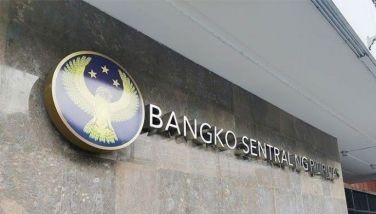Bangko Sentral’s pre-emptive strike
Last Thursday, the Bangko Sentral ng Pilipinas (BSP) raised the interest rate for its Special Deposit Account (SDA) facility by 25 bps, from 2.0 to 2.25 percent. Surprisingly, the financial markets reacted positively to the SDA rate increase. A day after the SDA rate hike, the PSE Index gained 0.47 percent and closed at 6,731 while the peso strengthened 0.11 percent to 43.81.
A paradox
Last year, the BSP cut its SDA rate by 150 bps. The move was aimed at limiting foreign flows into the SDA facility, reducing the BSP’s interest expenses and cushioning the over-strengthening of the peso. The stock market went up as some deposits from the SDA facility migrated to other asset classes such as equities. Moreover, the peso topped-out as operational adjustments on the SDA facility contributed in preventing the heavy inflow of foreign funds that were searching for higher yields.
Usually, the stock market goes up at the talk of lower interest rates and goes down at the prospect of higher interest rates. At the outset, it appears paradoxical that the SDA rate hike has caused our stock market to move up. It looks like experienced local fund managers understand the BSP’s actions as pre-emptive measures against inflation. Hence, these policy moves were welcomed by market pundits and are viewed as something positive for the economy, the peso and the stock market.
The Indian experience
To understand the wisdom of the BSP’s pre-emptive actions, we look at India’s experience last year. India’s persistently high inflation and widening current account deficit caused the Indian rupee to reach all-time lows and its stock market to drop severely. However, the Reserve Bank of India (RBI) acted decisively in increasing import taxes on gold and raising its policy rate multiple times. The RBI’s resolute moves stemmed the tide for India. As a result, the Indian rupee has since stabilized and India’s stock market has reached all-time highs this year.
The BSP’s policy arsenal
The SDA facility is one of the many tools that the BSP can use in fulfilling its mandate of price and financial stability. Below, we enumerate the tools in the BSP’s policy kit.
1. Reverse repurchase (RRP) / overnight borrowing facility. The RRP / overnight borrowing rate is the BSP’s main policy tool. It sets the interest rate that the BSP will pay for deposits that banks make into the facility. A policy rate hike would hence be viewed as a tightening move, as it attracts money into the facility, resulting to less money circulating in the financial system. Though the BSP has not yet hiked its policy rate, it has used other tools this year to gradually tighten monetary conditions.
2. Special deposit account (SDA) facility. The SDA facility allows banks and BSP-supervised trust entities to make deposits with the BSP. The BSP has traditionally used the SDA facility to mop out unwanted or excess liquidity in the system. Similar to a policy rate hike, the SDA rate hike attracts more money into the SDA facility, resulting to less money in the financial system.
3. Reserve requirement ratio (RRR). The RRR refers to the proportion of banks’ deposits and deposit substitute liabilities that banks are required to hold as reserves. So far this year, the BSP has increased the RRR twice, each by 100 bps. This means that banks have to keep more reserves and have less available funds for lending. These moves were aimed at controlling excess liquidity in the financial system.
4. Rediscounting facility. This facility allows banks to borrow money from the BSP by using promissory notes and other loan papers of their borrowers as collateral. This gives banks easier access to funds, thereby facilitating faster credit growth. Conversely, limiting access to the rediscounting facility would be seen as a tightening move.
5. Outright sales / purchases of government securities. Similar to what is being done by the Fed in the US or by the BOJ in Japan, the BSP can also influence monetary policy through the buying and selling of government securities. Though this policy option is available to the BSP, it has not used this as extensively as its counterparts in developed countries.
The specter of inflation
Our country’s inflation is still manageable and still falls within the BSP’s target range. However, inflation for the month of May increased to 4.5 percent, the highest level in 30 months. The uptick in inflation was driven by higher food prices and higher electricity prices. Higher food prices were caused by the surge in the prices of basic commodities, such as rice, garlic and onion. These were brought about by lower agricultural production due to weather disturbances, as well as moves by the government to curtail the smuggling of basic commodities.
Lately, oil prices have started to creep up due to the escalating sectarian violence in Iraq, the world’s 3rd biggest oil exporter. A prolonged war in the Middle East will result to higher oil prices for the rest of the world. Elevated oil prices for an extended period of time do not bode well for the global economy as a whole, more so for oil-importing countries such as the Philippines.
Considering these, it is clear that inflation is a problem that must be tackled sooner than later. If the BSP abstained from making a policy move last week, our stock market would have gone down and the peso would have continued weakening.
Hawkish stance
On top of the important policy tools that the BSP has on its disposal, the regulator has also used ‘language’ to convey its intentions and telegraph its moves. In previous interviews and press releases, the BSP said that it stands ready to act against any build-up of inflation. Below are some of the pertinent quotes from recent press releases by the BSP and recent interviews with the BSP’s top officials.
1. “The BSP has to take pre-emptive action to address the momentum of inflation.â€
2. “We will not hesitate to adjust policy settings should the inflation target be at riskâ€.
3. “The BSP will remain vigilant against a potential build-up in inflation expectations and financial imbalances.â€
4. “The BSP stands ready to undertake further policy actions as necessary to safeguard price and financial stability.â€
We believe the BSP’s hawkish stance on monetary policy comes at a very appropriate time. The BSP’s actions and words are warranted, as our country cannot afford to let real interest rates stay negative for an extended period of time. Moreover, our country should not let its interest rate spread vs. developed countries narrow, as this would result to severe and unwanted capital outflows. More importantly, the BSP’s recent actions and words show that it has a knack for knowing and doing what is needed by the market and the economy.
Peso appreciation – the secret weapon
Since most banks benchmark their deposit costs to the SDA rate, last week’s SDA rate hike may be seen as a de facto rate hike by the BSP. The move will preserve our interest rate spread vs. developed markets. Europe has recently moved to push deposit rates into negative territory while Japan is in the midst of undertaking its own brand of quantitative easing (QE). The US is definitely ahead of the curve compared to Europe and Japan. However, recent pronouncements from the Fed signal that the US will not be raising interest rates anytime soon. Considering these, the BSP’s SDA rate hike and possible rate hikes in the next 6 months would lead to capital flows and consequently peso appreciation. A certain level of peso appreciation would be desirable at a time like this. A stronger peso would effectively reduce the cost of our imports and curb inflation to a certain degree. Hence, the peso’s appreciation is a secret weapon that the BSP may also wield in addressing inflation concerns.
BSP – in command
The BSP has done a magnificent job of steering monetary policy in the right direction in the past few years. Note that our central bank has done this at a challenging time when external shocks and global headwinds have become the norm. Hence, the BSP truly deserves the numerous awards and accolades that it has received from various international institutions. This affirms our conviction that the BSP is truly one of the best central banks in the world.
It appears that the BSP is firmly in control as it deals with the specter of inflation. The BSP clearly understands our country’s economic and financial position. The regulator also knows exactly what to do and when to push the right buttons. Further, it still has a full arsenal of policy tools at its disposal. Aside from these, the BSP’s effective use of hawkish language, pronouncements of a tightening bias and other unconventional tools will help the central bank achieve its objectives. Considering these, the most recent pre-emptive strike of the BSP gives us confidence that the BSP is firmly in command of the situation.
For further stock market research and to view our previous articles, please visit our online trading platform at www.wealthsec.com or call 634-5038. Our archived articles can also be viewed at www.philequity.net.
- Latest
- Trending






























